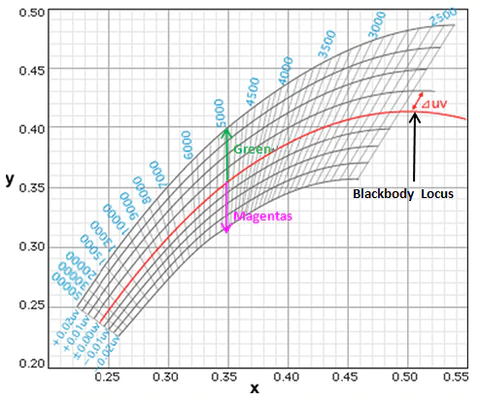Duv measures the derivation from the black body curve. Any value positive (above) shifts towards the green, while any value negative (below) shifts towards magenta.
At present we provide products meeting ANSI standards:
American National Standards Institute (ANSI)
Nominal CCT1) Target CCT and tolerance (K) Target Duv and tolerance
2700 K 2725 ± 145 0.000 ± 0.006
3000 K 3045 ± 175 0.000 ± 0.006
3500 K 3465 ± 245 0.000 ± 0.006
4000 K 3985 ± 275 0.001 ± 0.006
4500 K 4503 ± 243 0.001 ± 0.006
5000 K 5028 ± 283 0.002 ± 0.006
5700 K 5665 ± 355 0.002 ± 0.006
6500 K 6530 ± 510 0.003 ± 0.006
2. Have already developed wider CCT light source.
We focus on developing wide CCT all the time. So far we ensure the extremely high CRI (95+) between 1900K and 5600K, the process is in the test stage, after which the new CCT LEDs will come into the market.
3. Finished the development of bicolor ribbon.
We expect to eradicate the clients’ scruple about choosing the CCT, by placing alternating color temperature LEDs on a single ribbon. Presently we use SMD3528, dimming 3200K to 5600K, CRI 90+, the process is in the test stage as well.
4. Higher power COBs with 95+ CRI
Higher power LEDs using violet diodes with output up to 30W are currently under development.

